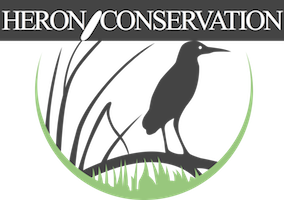Diurnal foraging in short pasture by the Endangered Australasian Bittern (Botaurus poiciloptilus) on Kangaroo Island, Australia
Abstract
The Australasian Bittern (Botaurus poiciloptilus) is a globally endangered species that has undergone a decline in population associated with loss of wetlands and changes to hydrology. Australasian Bitterns typically utilise wetlands composed of reeds, sedges, rushes and other fringing or emergent vegetation. Here, I document the use of short open pasture and shallow ephemeral wetland with no fringing or emergent vegetation, on Kangaroo Island, South Australia, during the day. The observation provides further evidence that the Australasian Bitterns forage diurnally, especially in winter. This is only the fourth record of this species for Kangaroo Island, and reasons for this paucity of records are explored in light of recent research suggesting movement from the species’ stronghold in the Riverina of the Murray-Darling Basin to coastal wetlands.
Key words: Australasian Bittern, diurnal feeding, foraging habitat, Kangaroo Island, vagrant.
Introduction
The Australasian Bittern (Botaurus poiciloptilus) occurs in south-eastern mainland Australia, south-western Australia, New Zealand and New Caledonia. The species is globally Endangered (BirdLife International 2016), endangered in Australia (Commonwealth of Australia 2019, Threatened Species Scientific Committee 2019, Herring et al. 2021) and listed endangered or critically endangered in most of the Australian mainland states in which it occurs. In Australia, the Australasian Bittern has undergone population declines attributed to draining of and changes of hydrology to wetlands in the species’ stronghold of the Murray-Darling Basin (Buchanan 2009, Maddock 2011, Herring et al. 2021).
Recent research is revealing new insights into habitat use (e.g., ricefields) and movements (e.g., Herring et al. 2019). As such, documenting new information on range, habitat and behaviour is important. Here, I describe observations on the fourth record of this species on Kangaroo Island, South Australia, habitat use and activity, and explore reasons for the paucity of records on the Island in light of new research on the species’ movements.
Observations and Discussion
An Australasian Bittern was seen in an open paddock of damp short pasture grass grazed by sheep at ~13:00 hr off Cape Willougby Road, Cuttlefish Bay, Kangaroo Island (35° 44' 13" S, 137° 59' 48" E), on 13 August 2007. At first it was standing stationary in a resting position (sensu Whiteside 1989) but gradually begun moving its head upwards (Fig. 1). It then slowly walked approximately 20 m to the edge of a shallow ephemeral wetland within the paddock – a wetland with no fringing (other than grazed pasture grass) or emergent vegetation – where it assumed an alarm posture with head pointed diagonally upward (Fig. 2), before flying towards a thicket of Scarlet Bottlebrush (Callistemon rugulosus) approximately 80 m away (Fig. 3). The observations lasted approximately 2 mins.
The Australasian Bittern is considered to be a vagrant on Kangaroo Island (Baxter 1995, 2015, Robinson and Armstrong 1999, Gillam and Urban 2014) and most distribution maps do not include Kangaroo Island in its distribution (e.g., Marchant and Higgins 1990, McKilligan 2005, Herring et al. 2021, eBird 2022) although the Fleurieu Peninsula, the nearest mainland point, typically is included (Fig. 4).
Kangaroo Island has been subject to multiple bird surveys and compilations of bird lists and distributions (Baxter 1995, 2015, Paton et al. 2002, Boulton et al. 2020). The observations described above represent the fourth record of Australasian Bittern on Kangaroo Island (Baxter 2015, Birds SA 2020).
Baxter (2015) documented previous occurrences on Kangaroo Island: “Rare; 4 observations; a specimen collected from Rocky River, FCNP [Flinders Chase National Park], Apr 1940 (SAM B22204); one at Chapman River estuary, Dudley Peninsula, Nov 1945 (possible misidentification of juvenile Nankeen Night Heron; paperbark-fringed estuary at this location supports a small breeding night heron colony); one in Pale Rush at Lake Kitty, near Stunsail Boom mouth, 30 June 1986; one photographed in open paddock with pocket of flooded Scarlet Bottlebrush near Cuttlefish Bay, Dudley Peninsular, 13 Aug 2007” (p. 152). The last observations were my observations described in this paper and provided earlier to Baxter (2015).
In Australia, the Australasian Bittern occurs mainly in freshwater wetlands where it favours permanent and seasonal wetlands with tall dense vegetation, particularly those dominated by sedges, rushes and reeds (e.g., Phragmites, Cyperus, Eleocharis, Juncus, Typha, Baumea, Bolboschoenus) or cutting grass (Gahnia) from 0.5-3.5 m in height growing over a muddy or peaty substrate (Marchant and Higgins 1990). It rarely uses estuaries or tidal wetlands (Marchant and Higgins 1990) and, in more recent decades, uses rice fields (Herring et al. 2019). The Australasian Bittern forages in still, shallow water up to 0.3 m deep, often at the edges of pools or waterways, or from platforms or mats of vegetation over deep water (Marchant and Higgins 1990). In south-western Western Australia, it also utilises swamps with shrubs (Melaleuca spp., Agonis spp.) (Pickering 2013; R. P. Jaensch, unpublished, in Herring et al. 2021).
In a comprehensive review of the species in Australia and New Zealand, Marchant and Higgins (1990) did not list open, short pasture as a habitat type. However, more recently, Herring et al. (2021) note that “on occasion, they can feed away from water bodies such as in grassland or crop stubble, particularly during rodent plagues (A. Silcocks unpublished)” (p. 223), while Martínez-Vilalta et al. (2020a) state “only occasionally in open areas” but provide no further details. Rees (2015) photographed an Australasian Bittern walking through short pasture in New Zealand.
Although the species is suggested to mostly feed at night, dusk or dawn (Marchant and Higgins 1990, McKilligan 2005, Martínez-Vilalta et al. 2020a), it is increasingly being shown to feed by day, especially in winter (Whiteside 1989, Menkhorst and Silcocks 2004, Menkhorst 2012, Gitsham 2018, this paper). Similarly, Gu et al. (2019) found Eurasian Bitterns (Botaurus stellaris) to be largely diurnal in their activity during winter in China, despite being considered to be mostly crepuscular and nocturnal by others (e.g., Martínez-Vilalta et al. 2020b).
New insights from satellite tagged birds suggest Australasian Bitterns disperse from the Murray-Darling Basin’s Riverina district to coastal wetlands in South Australia, Victoria and New South Wales (Herring et al. 2016, 2019, 2021), typically in winter. Three of the four records from Kangaroo Island are from winter (including the observation described in this paper). The paucity of records of Australasian Bitterns on Kangaroo Island raises a number of interesting questions. Kangaroo Island is Australia’s third largest island at 440,000 hectares and contains intact and high quality wetlands (Seaman 2002). At its closest point, Kangaroo Island is 13.5 km from the Fleurieu Peninsula on mainland Australia. Is this sea barrier an impediment to more regular movements or is the species simply under-reported on Kangaroo Island?
Herring et al. (2019) suggested the population of Australasian Bitterns in Tasmania “may also be supplemented by birds from the mainland, including from the Riverina. Although no crossing of Bass Strait has been documented, the species has been recorded on both Flinders and King Islands in Bass Strait (Green, 1969; Green and McGarvie, 1971; McGarvie and Templeton, 1974), and the Eurasian Bittern is a regular long-distance migrant across marine barriers (Cramp and Simmons, 1977)” (p. 6). Martínez-Vilalta et al. (2020b) note a number of islands where the Eurasian Bittern occurs in the non-breeding season and individuals of this species move between the UK and continental Europe (Brown et al. 2012), while Gu et al. (2019) installed GPS/GSM loggers on Eurasian Bitterns in China and found they crossed Bohai Bay, a distance of approx. 440 km at its longest point. The extent to which the Australasian Bittern undertakes sea crossings across the Southern Ocean in winter is an area for further research.
Alternatively, Australasian Bitterns may occur on Kangaroo Island more often than reported. The island has a relatively small population (5,000 people) and much of the island is not accessible to birdwatchers (being private farming properties or remote and inaccessible protected areas). This, combined with their usually cryptic nature, may make Australasian Bitterns hard to detect. Grazing of the ephemeral wetland has likely reduced habitat suitability at this site, and probably others on the island, for this cover dependent species. Managing grazing in ways that enable emergent vegetation stands to develop could benefit habitat values for Australasian Bitterns on Kangaroo Island.
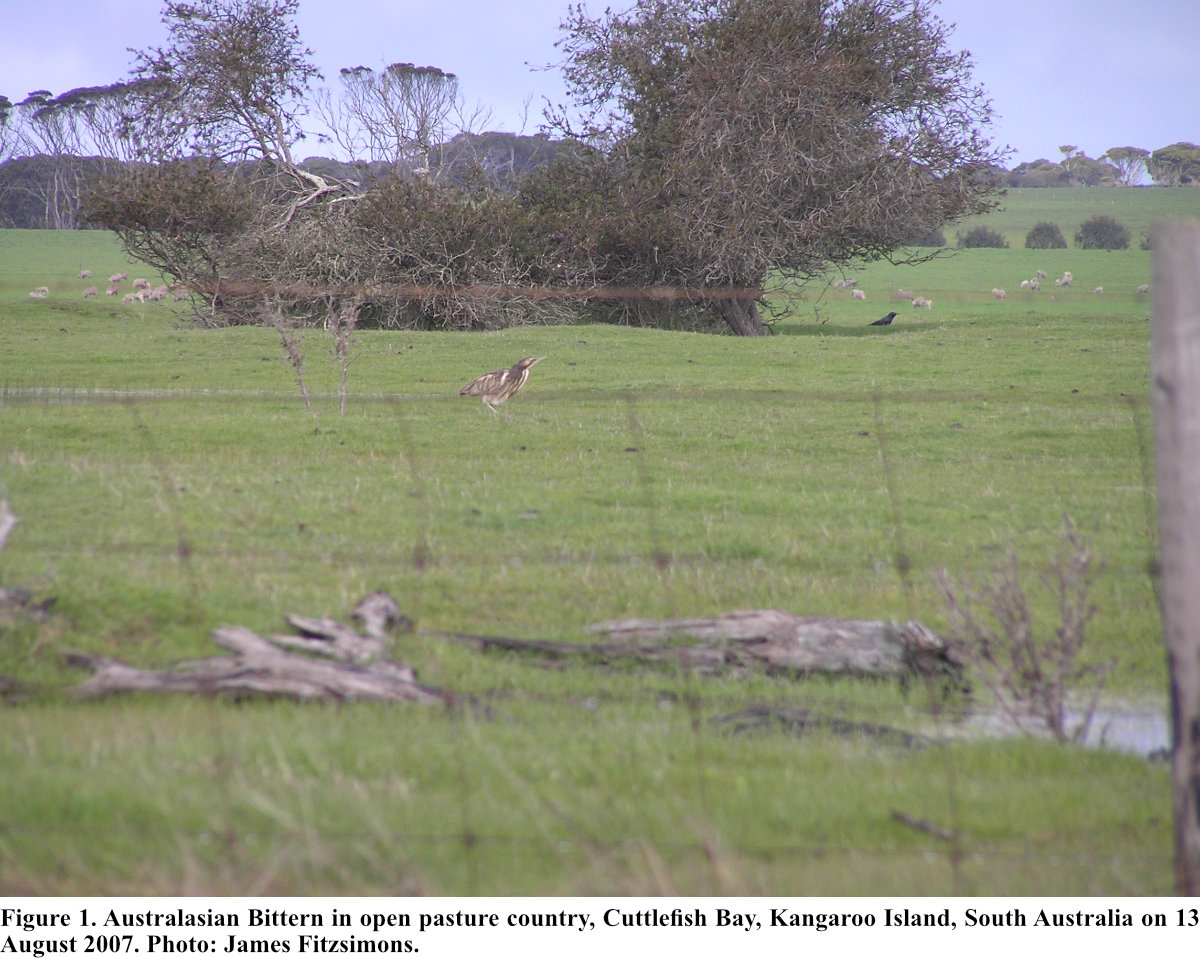
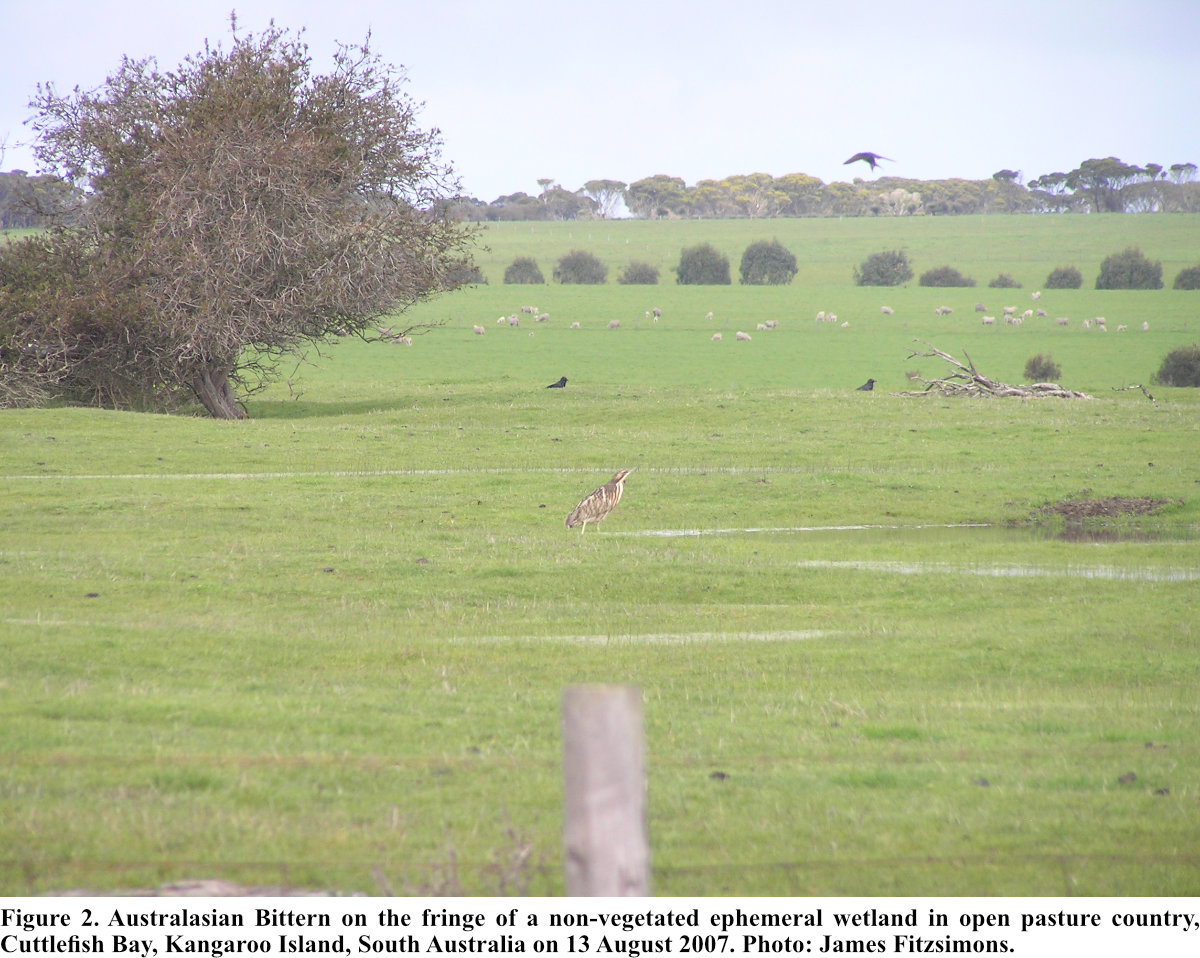
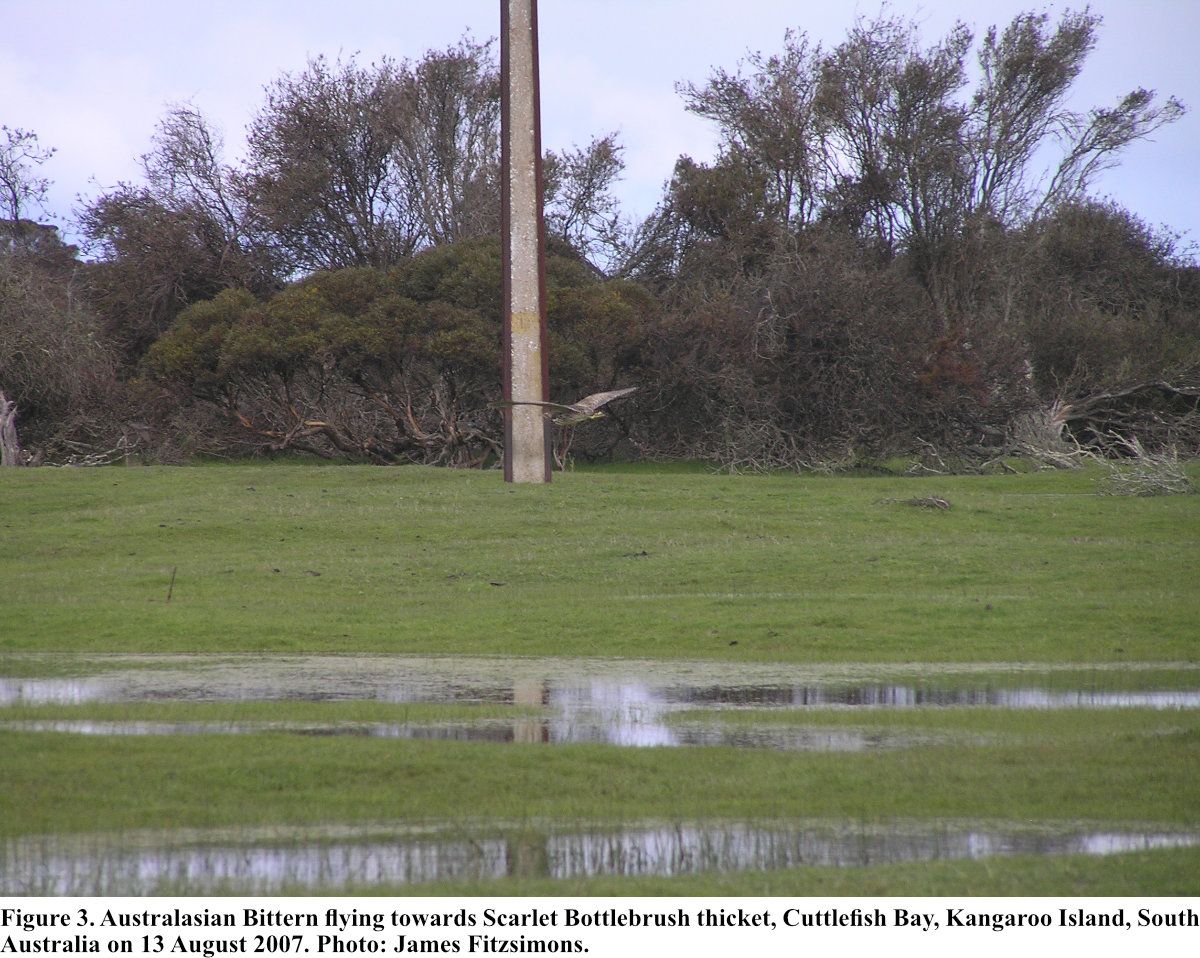
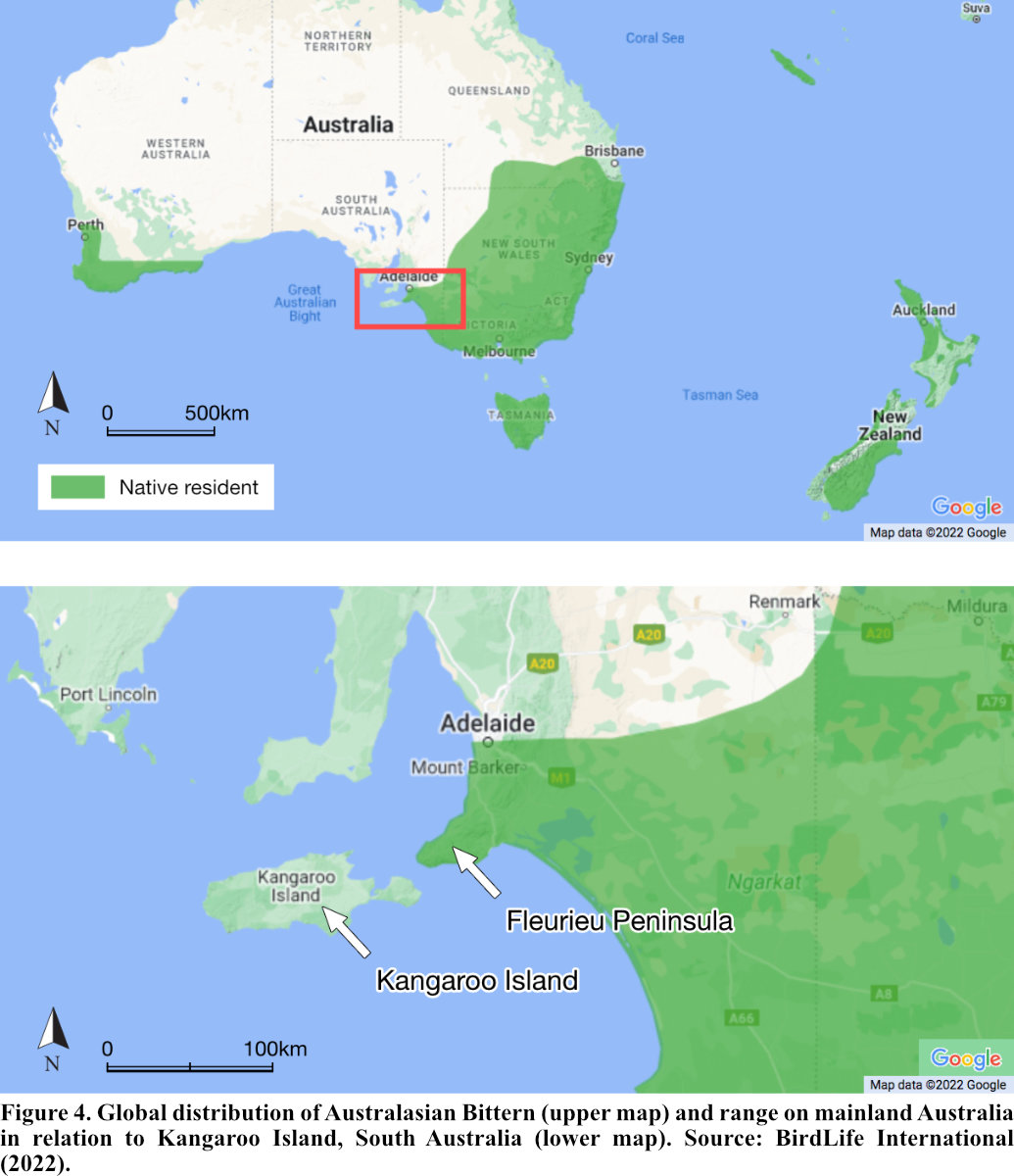
Acknowledgements
Thanks to Janelle Thomas and the late Chris Baxter for discussions on this observation, and to Chip Weseloh and two anonymous reviewers for helpful comments on a draft of this paper.
Literature Cited
Baxter, C. 1995. An annotated list of the birds of Kangaroo Island (revised edition). South Australia National Parks and Wildlife Service, Adelaide, Australia.
Baxter, C. 2015. Birds of Kangaroo Island: A photographic field guide. ATF Press, Adelaide, Australia.
BirdLife International. 2016. Australasian Bittern Botaurus poiciloptilus. The IUCN Red List of Threatened Species 2016: e.T22697353A93610014. [online]. Accessed 25 June 2022.
BirdLife International. 2022. Species factsheet: Australasian Bittern Botaurus poiciloptilus. [online]. Accessed 25 June 2022.
Birds SA. 2020. Australasian Bittern Botaurus poiciloptilus [South Australian distribution map 20/02/2020]. [online]. Accessed 25 June 2022.
Boulton, R., T. Hunt, L. Ireland and J. Thomas. 2020. Kangaroo Island rapid bird assessments, February 2020. BirdLife Australia, Melbourne, Australia.
Brown, A., G. Gilbert and S. Wotton. 2012. Bitterns and bittern conservation in the UK. British Birds 105: 58-87.
Buchanan, K. L. 2009. Wetland conservation in the Murray-Darling Basin — is it going down the drain? Emu - Austral Ornithology 109: i-iv.
Commonwealth of Australia. 2019. Draft national recovery plan for the Australasian Bittern. Department of Energy and the Environment, Canberra, Australia.
Cramp, S. and K. E. L. Simmons (eds.). 1977. The birds of the Western Palearctic. Volume 1. Ostrich to Ducks. Oxford University Press, Oxford, U.K.
eBird. 2022. Australasian Bittern Botaurus poiciloptilus. [online]. Accessed 25 June 2022.
Gillam, S. and R. Urban. 2014. Regional species conservation assessment project, phase 1 report: regional species status assessments, Kangaroo Island NRM Region. Department of Environment, Water and Natural Resources, South Australia, Australia.
Gitsham, J. 2018. The observation and photographic documentation of an Australasian Bittern catching and consuming a small mammal. South Australian Ornithologist 42: 71-74.
Green, R. H. 1969. The birds of Flinders Island. Records of the Queen Victoria Museum No. 34. Queen Victoria Museum, Launceston, Australia.
Green, R. H. and A. M. McGarvie. 1971. The birds of King Island. Records of the Queen Victoria Museum No. 40. Queen Victoria Museum, Launceston, Australia.
Gu, D., Y. Chai, Y. Gu, J. Hou, L. Cao and A. D. Fox. 2019. Annual migration routes, stopover patterns and diurnal activity of Eurasian Bitterns Botaurus stellaris wintering in China. Bird Study 66: 43-52.
Herring, M., I. Veltheim and A. Silcocks. 2016. Robbie’s gone a roaming. Australian Birdlife 5(3): 26-31.
Herring, M. W., W. Robinson, K. K. Zander and S. T. Garnett. 2019. Rice fields support the global stronghold for an endangered waterbird. Agriculture, Ecosystems and Environment 284: 106599.
Herring, M. W., P. Barratt, A. H. Burbidge, M. Carey, A. Clarke, S. Comer., B. Green, R. Pickering, C. Purnell, A. Silcocks, V. Stokes, E. Znidersic, R. P. Jaensch and S. T. Garnett. 2021. Australasian Bittern Botaurus poiciloptilus. Pages 222-224 in The Action Plan for Australian Birds 2020 (S. T. Garnett and G. B. Baker, eds.). CSIRO Publishing, Melbourne, Australia.
Maddock, M. 2011. The status of herons and their wetland habitat in southeastern Australia, 2000-2010. Journal of Heron Biology and Conservation 1: 7. [online].
Marchant, S. and P. J. Higgins (eds.) 1990. Handbook of Australian, New Zealand and Antarctic birds. Vol. 1: Ratites to Ducks. Oxford University Press, Melbourne, Australia.
Martínez-Vilalta, A., A. Motis and G. M. Kirwan. 2020a. Australasian Bittern (Botaurus poiciloptilus), version 1.0. In Birds of the World (J. del Hoyo, A. Elliott, J. Sargatal, D. A. Christie, and E. de Juana, eds.). Cornell Lab of Ornithology, Ithaca, New York, U.S.A. [online]. Accessed 25 June 2022.
Martínez-Vilalta, A., A. Motis and G. M. Kirwan. 2020b. Great Bittern (Botaurus stellaris), version 1.0. In Birds of the World (J. del Hoyo, A. Elliott, J. Sargatal, D. A. Christie and E. de Juana, eds.). Cornell Lab of Ornithology, Ithaca, New York, U.S.A. [online]. Accessed 25 June 2022.
McKilligan, N. 2005. Herons, egrets and bitterns: their biology and conservation in Australia. CSIRO Publishing, Melbourne, Australia.
McGarvie A. M. and M. T. Templeton. 1974. Additions to the birds of King Island, Bass Strait. Emu 74: 91-96.
Menkhorst, P. 2012. The food and foraging rate of an Australasian Bittern. Australian Field Ornithology 29: 133-142.
Menkhorst, P. and A. Silcocks. 2004. Observations of Australasian Bittern eating small mammals. Australian Field Ornithology 21: 37-39.
Paton, D. C., J. A. Gates and L. P. Pedler. 2002. Birds. Pages 88-110 in Natural History of Kangaroo Island, 2nd edition. (M. Davies, C. R. Twidale and M. J. Tyler, eds.). Royal Society of South Australia Inc, Adelaide, Australia.
Pickering, R. 2013. Australasian Bittern in Southwest Australia. BirdLife Australia, Melbourne, Australia. [online]. Accessed 25 June 2022.
Rees, G. 2015. Australasian bittern | Matuku-hūrepo. Adult walking through pasture. Eastern Southland, August 2015. New Zealand Birds. [online]. Accessed 25 June 2022.
Robinson, A. C. and D. M. Armstrong (eds.). 1999. A biological survey of Kangaroo Island, South Australia, 1989 and 1990. Heritage and Biodiversity Section, Department for Environment, Heritage and Aboriginal Affairs, South Australia, Australia.
Seaman, R. L. 2002. Wetland inventory of Kangaroo Island: An assessment of selected inland wetlands of Kangaroo Island, South Australia. Department for Environment and Heritage, Adelaide, Australia.
Threatened Species Scientific Committee. 2019. Conservation advice Botaurus poiciloptilus Australasian Bittern. Threatened Species Scientific Committee, Canberra, Australia. [online]. Accessed 25 June 2022.
Whiteside, A. J. 1989. The behaviour of bitterns and their use of habitat. Notornis 36: 89-95.
